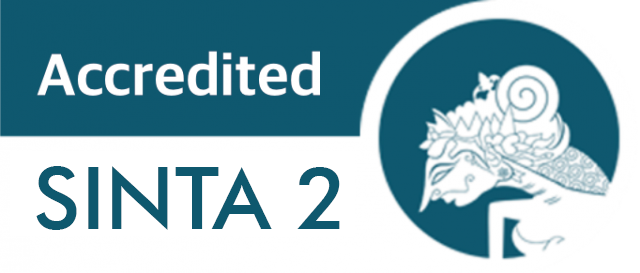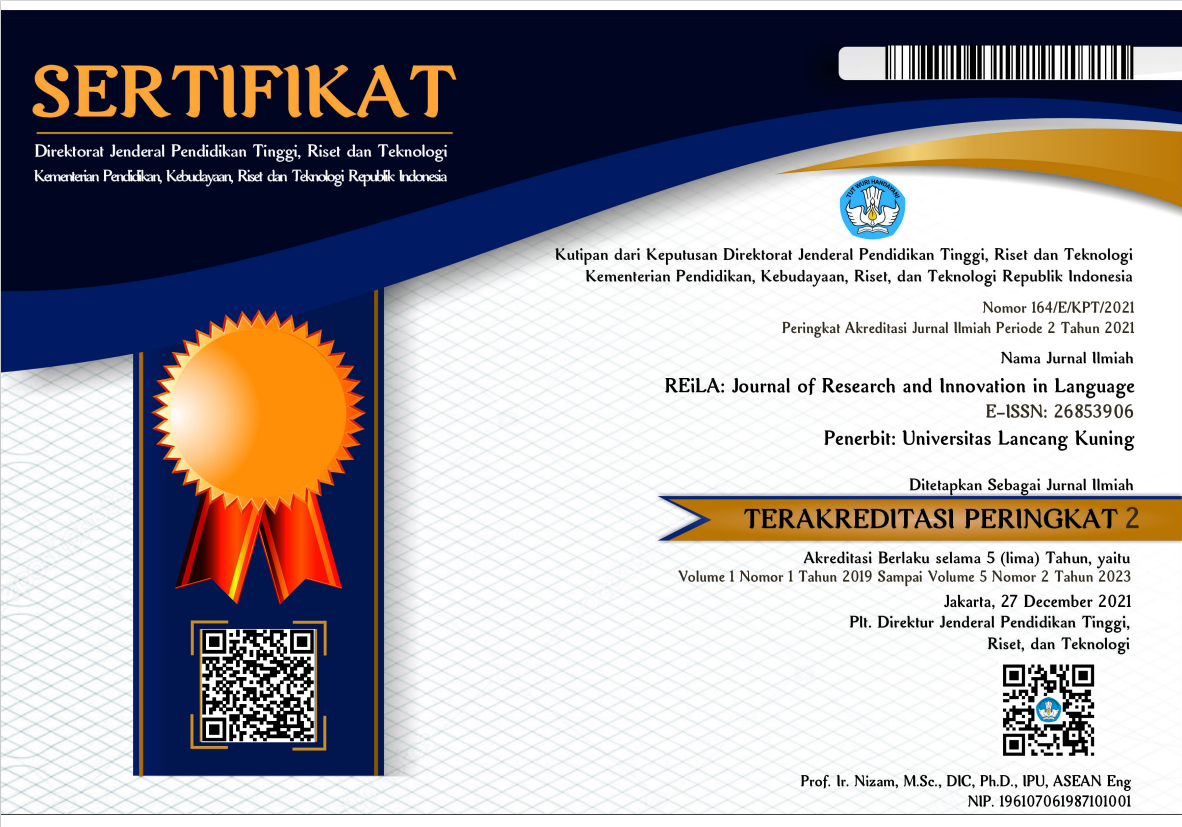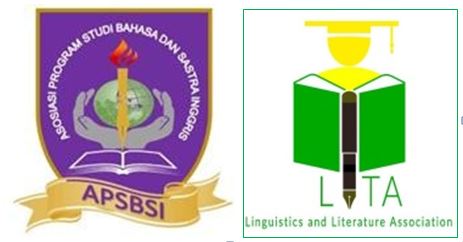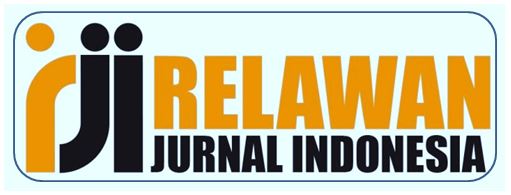Discourse Analysis in E-Learning-Based Course Using Moodle Platform: An Experimental Design
Abstract
The COVID-19 pandemic has caused educational institutions all over the world to migrate their teachings online. Since Indonesian government issued the SK Mendiknas No. 107/U/2001, educational institutions had to steadily integrate their learning process with technology. So, this study intends to investigate the effectiveness of using the open-source learning platforms known as Moodle in a selected university, Universitas Lancang Kuning (Unilak) in Indonesia. While multiple courses uses Moodle, this study selected to analyse the 2017/2018 fifth semester students as they are the ones who pioneered Moodle for other classes to use. With a quasi-experimental research design, this study used four types of test to calculate the results of the essay pre-test and post-test on both experimental and control classes. With the eventual mean of 65.53 for the experimental class and 63.25 for the control, this study proved that Moodle does effectively improve Indonesian university EFL students’ learning compared to conventional lecture-style learning. Future research is hoped to extend or compare this study with an investigation on how university EFL students are using e-learning during the COVID-19 pandemic and other factors that have not been covered in this empirical study.
Downloads
References
Ainsworth, S. (2017). Discourse Analysis/Methods. The International Encyclopedia of Organizational Communication, 1-14.
Al-Fraihat, D., Joy, M., & Sinclair, J. (2020). Evaluating E-learning systems success: An empirical study. Computers in Human Behavior, 102, 67-86.
Bataineh, R. F., & Mayyas, M. B. (2017). The Utility of Blended Learning in EFL Reading and Grammar: A Case for Moodle. Teaching English with Technology, 17(3), 35-49.
Chang, M. M., & Lan, S. W. (2019). Exploring undergraduate EFL students’ perceptions and experiences of a Moodle-based reciprocal teaching application. Open Learning: The Journal of Open, Distance and e-Learning, 1-16.
Choudhury, S., & Pattnaik, S. (2020). Emerging themes in e-learning: A review from the stakeholders' perspective. Computers & Education, 144, 103657.
Cigdemoglu, C., Arslan, H. O., & Akay, H. (2011). A Phenomenological Study of Instructors’ Experiences on an Open Source Learning Management System. Procedia-Social and Behavioral Sciences, 28, 790-795.
Creswell, J. W. (2002). Educational research: Planning, conducting, and evaluating quantitative (pp. 146-166). Upper Saddle River, NJ: Prentice Hall.
Derin, T., Putri, N. S., Nursafira, M. S., & Hamuddin, B. (2020). Discourse Analysis (DA) in the Context of English as a Foreign Language (EFL): A Chronological Review. ELSYA: Journal of English Language Studies, 2(1), 1-8.
Farajollahi, M., & Zarifsanaee, N. (2012). Distance Teaching and Learning in Higher Education: A Conceptual Model. International Perspectives of Distance Learning in Higher Education, 13-32.
Hamuddin, B., Syahdan, S., Rahman, F., Rianita, D., & Derin, T. (2019). Do They Truly Intend to Harm Their Friends?: The Motives Beyond Cyberbullying among University Students. International Journal of Cyber Behavior, Psychology and Learning (IJCBPL), 9(4), 32-44.
Harianja, R., Yudar, R. S., Deliani, S., Nursafira, M. S., & Hamuddin, B. (2019). An Analysis of Pronouns Used in Selected International Journal Articles: Exploring Authors’ Flexibility and Consistency. REiLA: Journal of Research and Innovation in Language, 1(3), 73-78.
Herlinawati, H., Saukah, A., Mukminatien, N., Isnawati, U. M., & Bastian, A. (2020). Do Comprehensive and Selective Corrective Feedback Really Work for L2 Writing Accuracy? An Overview from Indonesian Context. Humanities & Social Sciences Reviews, 8(1), 69-77.
Horvat, A., Dobrota, M., Krsmanovic, M., & Cudanov, M. (2015). Student perception of Moodle learning management system: a satisfaction and significance analysis. Interactive Learning Environments, 23(4), 515-527.
Junaidi, J., Hamuddin, B., Simangunsong, W., Rahman, F., & Derin, T. (2020). ICT Usage in Teaching English in Pekanbaru: Exploring Junior High School Teachers’ Problems. International Journal of Advanced Science and Technology, 29(3), 5052-5063.
Kautsar, I. A., Musashi, Y., Kubota, S. I., & Sugitani, K. (2014, April). Developing Moodle plugin for creating learning content with another REST function call. In 2014 IEEE Global Engineering Education Conference (EDUCON) (pp. 784-787). IEEE.
Klaus, B. (2005). Are You Ready to “Moodle”? Language, Learning and Technology, 9(2):16-23.
Liu, D. Y. T., Atif, A., Froissard, J. C., & Richards, D. (2019, January). An enhanced learning analytics plugin for Moodle: student engagement and personalised intervention. In ASCILITE 2015-Australasian Society for Computers in Learning and Tertiary Education, Conference Proceedings.
Marwa, M., & Herdi, H. (2017). Do Native Speakers in Youtube Videos Benefit EFL Students’ Phonological Appropriation?. Lectura: Jurnal Pendidikan, 8(2).
Paturusi, S., Chisaki, Y., & Usagawa, T. (2014, September). Development and evaluation of online quizzes to enhance learning performance: A survey of student assessment through MOODLE in Indonesian National University. In Proceedings of International Conference on Information, Communication Technology and System (ICTS) 2014 (pp. 211-216). IEEE.
Putri, N. S. (2019). Kahoot Application in English Language Teaching (ELT) Context: An Alternative Learning Strategy. ELSYA: Journal of English Language Studies, 1(1), 11-15.
Risani, T. D. (2020). Writing News Item in English Language Teaching Context: Line Apps Platform for Senior High School Students. Utamax: Journal of Ultimate Research and Trends in Education, 2(1), 24-28.
Sari, A., & Setiawan, A. (2018). The Development of Internet-Based Economic Learning Media using Moodle Approach. International Journal of Active Learning, 3(2), 100-109.
Solutions, L. (2017). The complete Moodle user guide. Retrieved 22 April 2020 from https://www.lambdasolutions.net/guides-and-research/moodle-user-guide-intro-to-moodle
Sugiyono, DR (2006). Statistics for Research. Bandung: CV. Alfabeta.
Sulisworo, D., Agustin, S. P., & Sudarmiyati, E. (2016). Cooperative-blended learning using Moodle as an open source learning platform. International Journal of Technology Enhanced Learning, 8(2), 187-198.
Teo, T., Zhou, M., Fan, A. C. W., & Huang, F. (2019). Factors that influence university students’ intention to use Moodle: A study in Macau. Educational Technology Research and Development, 67(3), 749-766.
Van Leeuwen, T. (2008). Discourse and practice: New tools for critical discourse analysis. Oxford University Press.
Yudar, R. S., Aditomo, D. T., & Silalahi, N. S. (2020). Movie as a Helper for Students' Pronunciation in Speaking Skill Class. ELSYA: Journal of English Language Studies, 2(1), 15-19.
Zulkarnain, L. (2012). Use of Statistics in Social Research. Medan: Prime Publishing .










